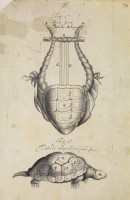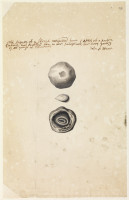Lyre, tortoise and plumb stone
Date
1702
Creator
Unknown, Engraver
Creator - Organisation
The Royal Society, Publisher
Object type
Article identifier
Material
Technique
Subject
Description
Three figures from issue 282 of Philosophical Transactions of the Royal Society.
Figures 1-2. An ancient Greek lyre (1), said to have been made from the shell of a tortoise, Testudinidae (2). Illustrations to ‘A Letter from Dr Thomas Molyneux, F. R. S. to the Right Reverend St George, Lord Bishop of Clogher in Ireland, containing some thoughts concerning the ancient Greek and Roman lyre, and an explanation of an obscure passage in one of Horace's odes’ in Philosophical Transactions of the Royal Society, vol. 23, issue 282 (December 1702). Original proofs of these images can be found in MS/131/181.
Figure 3. Calculus containing a plum stone, removed from the gut of a woman named Sarah Swayn, by James Young. Illustrations to ‘A letter from Mr James Young, F. R. S. to Dr Edward Tyson, F. R. S. concerning a ball extracted from a person, who had suffered by it 30 years, in which was a plumb-stone’ in Philosophical Transactions of the Royal Society, vol. 23, issue 282 (December 1702). Original drawing of these images, by Henry Hunt, can be found in MS/131/101.
Thomas Molyneux (1661 – 1733) British physician, was elected a Fellow of the Royal Society in 1686.
Figures 1-2. An ancient Greek lyre (1), said to have been made from the shell of a tortoise, Testudinidae (2). Illustrations to ‘A Letter from Dr Thomas Molyneux, F. R. S. to the Right Reverend St George, Lord Bishop of Clogher in Ireland, containing some thoughts concerning the ancient Greek and Roman lyre, and an explanation of an obscure passage in one of Horace's odes’ in Philosophical Transactions of the Royal Society, vol. 23, issue 282 (December 1702). Original proofs of these images can be found in MS/131/181.
Figure 3. Calculus containing a plum stone, removed from the gut of a woman named Sarah Swayn, by James Young. Illustrations to ‘A letter from Mr James Young, F. R. S. to Dr Edward Tyson, F. R. S. concerning a ball extracted from a person, who had suffered by it 30 years, in which was a plumb-stone’ in Philosophical Transactions of the Royal Society, vol. 23, issue 282 (December 1702). Original drawing of these images, by Henry Hunt, can be found in MS/131/101.
Thomas Molyneux (1661 – 1733) British physician, was elected a Fellow of the Royal Society in 1686.
Related fellows
Thomas Molyneux (1661 - 1733, Irish) , Physician
Associated place

